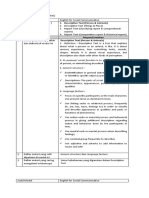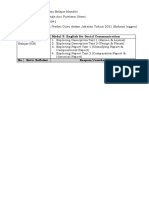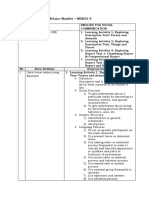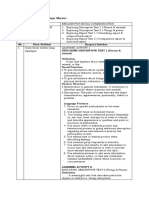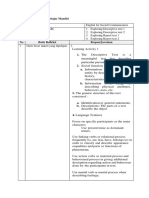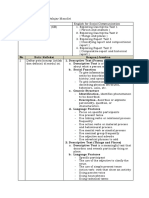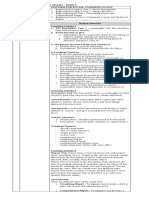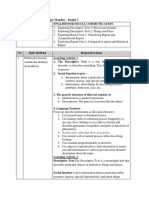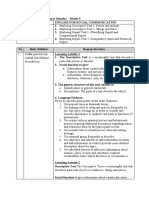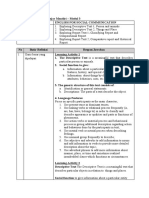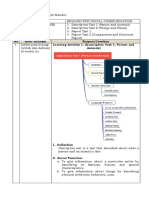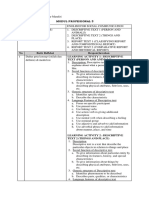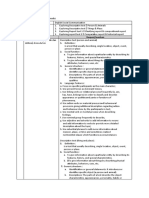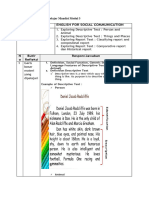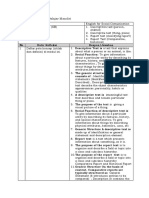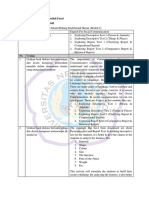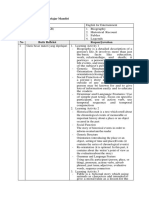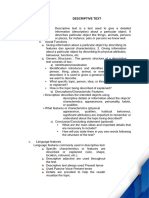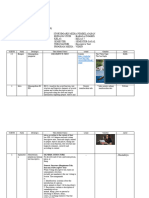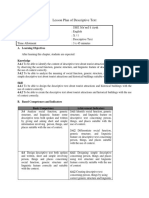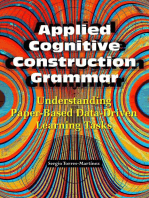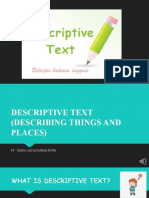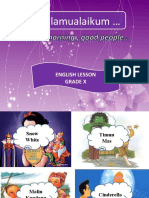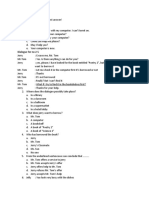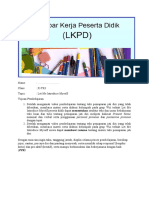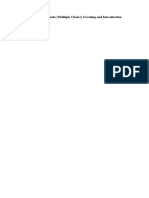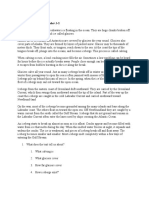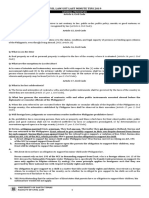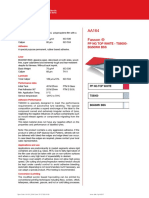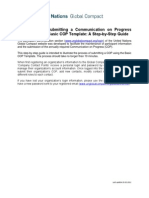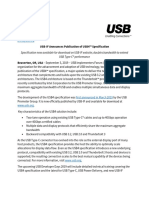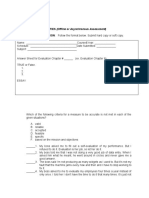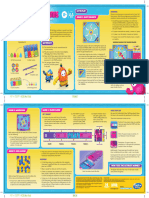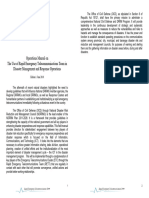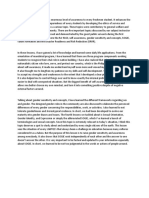Professional Documents
Culture Documents
LK 1 Modul 3
LK 1 Modul 3
Uploaded by
DindaCahyaKurniaPutriOriginal Description:
Copyright
Available Formats
Share this document
Did you find this document useful?
Is this content inappropriate?
Report this DocumentCopyright:
Available Formats
LK 1 Modul 3
LK 1 Modul 3
Uploaded by
DindaCahyaKurniaPutriCopyright:
Available Formats
LK 1: Lembar Kerja Belajar Mandiri
Judul Modul Modul 3: English For Social Communication
Judul Kegiatan Belajar (KB) 1. Learning Activity 1: Exploring Descriptive Text 1 (Person & animals)
2. Learning Activity 2: Exploring Descriptive Text 2 (Things & places)
3. Learning Activity 3: Exploring Report Text 1 (Classifying report &
compositional report)
4. Learning Actiivity 4 : Exploring Report Text 2 (Comparative report &
historical report)
No Butir Respon/Jawaban
Refleksi
1 Daftar peta 1. Exploring Descriptive Text 1 (Person & animals)
konsep
(istilah dan Exploring Descriptive Text 1
definisi) di
modul ini
Introduction Main Section Example of Descriptive text
1.Short
Describe Describe
Description Learning Learning
2. Relevance material and Person animal
Outcome
3. Lerning 1. Attitude activities
guide 2. Knowledge 1. Definition
3. Skill 2. Social
Function
3. Generic
Structure
a. Definition of Descriptive text about Person and animals
Descriptive Text is a text that explains about what a person or an animal, is like.
It is about sensory experience, how something looks, sounds, shapes.
b. Social Function
To give information about a particular entity by describing its features,
history, and special characteristics.
To give information about things by describing physical attributes, behaviors,
uses, etc.
c. Generic Structure
The generic structure of this text consists of :
Identification or general statements. It introduces or identifies specific object
(a person and animal).
Descriptions: The parts of a text describe the object characteristics,
appeareances, personality, habits or qualities
d. Language Features
Focus on specific participants as the main character;
Use present tense
Use linking verbs or relational process frequently (is, are, has, have, belongs
to)
Use action verbs or material process and behavioural process in giving
additional description regarding action and behaviour
Use mental verb or mental process when describing feelings;
Use nominal group frequently to describe;
Use adjective and adverbs
Use adverbial phrases
2. Exploring Descriptive Text 2 (Things & places)
Exploring Descriptive Text 2
Introduction Main Section Example of Descriptive text
1.Short
Describe Describe
Description Learning Learning
2. Relevance material and Thing Place
Outcome
3. Lerning 1. Attitude activities
guide 2. Knowledge 1. Definition
3. Skill 2. Social
Function
3. Generic
Structure
4.Language
Feature
Exploring Descriptive Text 2 (Thing & Places)
a. Definition of Descriptive text about Thing & Places
Descriptive Text is a meaningful text that describes and reveals particular
thing or place. The purpose of the text to give a visual picture of a thing, such as
my favourite books that describe specific books, or a picture of a tourism place.
b. Social Function
To give information about a particular entity by describing its features,
history, and special characteristics.
To give information about things by describing physical attributes,
behaviors, uses, etc.
c. Generic Structure
The generic structure of this text consists of :
Identification or general statements. It introduces or identifies specific object
(a person and animal).
Descriptions: The parts of a text describe the object characteristics,
appeareances, personality, habits or qualities
d. Language Features
Specific participant : it has a certain object, is not common and unique (only
one). for example: Bandengan beach, my house, Borobudur temple
The use of the adjective (an adjective) to clarify the noun, for example: a
beautiful beach, the famous place in jepara, etc
The use of simple present tense: The sentence pattern used is simplepresent
because it tells the fact of the object described
Action verb: verbs that show an activity (i.e, run, sleep, walk, cut etc)
Using passive voice
Using noun phrase
Using technical terms
Using general and abstract noun
Using conjunction of time and cause effect
3. Exploring Report Text 1 (Classifying report & compositional report)
Short Description
Relevance
Introduction
Learning guide
Attitude
Learning outcomes Knowledge
Skills
Exploring Report Text Main Section Definition
Social Function
Learning Material and Activities
Generic Structure
Language feature
classifying report
Example of Report Text compositional report
a. Definition of Report Text
Report Text t is a text which presents information about something, as it is.
b. Social Function
Classifying report : To organise and describe a field or topic into a class and
subclass hierarchy
Compositional report: To organise and describe a field or topic according to
its part (a part or whole part)
c. Generic Structure
The generic structure of this text consists of :
General statements/General Classification. It introduces the topic of the
report
Descriptions: it includes characteristic, functions and qualities.
d. Language Features
Use general nouns
Use present tense
Use linking verbs or relational process frequently (is, are, has, have, belongs
to)
Use technical terms
Use action verbs
Use articles
Sometimes use simple past tense to describe the history/event
4. Exploring Report Text 2 (Comparative report & historical report)
Exploring Report Text 2
Introduction Main Section Example of Report text
1.Short
Description Comparative Historical
Learning Learning
report report
2. Relevance Outcome material and
3. Lerning 1. Attitude activities
guide 2. Knowledge 1. Definition
3. Skill 2. Social
Function
3. Generic
Structure
a. Definition of Report text about (Comparative report & historical report)
The texts are concerned with general categories of things rather than events
and happenings and with informing about technical and scientific topics.
b. Social Function
Comparative report : To identify the similarities and differences
between two or more classes or things
Historical report : To give information about the way
things were in relation to a particular historical period or site
c. Generic Structure
Comparative reports are typically structured as follows:
• General Statement :
It introduces entities to be compared
• Description:
It contains the systematic analysis of similarities and differences
Historical reports are typically structured as follows:
• General Statement
It Identifies historical period or site
And it defines and locates in time and place
• Description
- Features or characteristics
- Activities
- Behaviours
- Artefacts
- Historical
d. Language Features
• Generalised participants are initially represented in simple noun groups
• Relating verbs that link an entity with its attributes
• Timeless present tense (with the exception of an historical report)
• Attitudinal vocabulary is unusual as the emphasis is on facts rather on
opinions
2 Daftar 1. Compositional Report
materi yang 2. Comparative Report
sulit
dipahami di
modul ini
3 Daftar 1. Compositional Report
materi yang 2. Comparative Report
sering
mengalami
miskonsepsi
You might also like
- Genius Guide To The Dragonrider (Revised)Document13 pagesGenius Guide To The Dragonrider (Revised)Gui MachadoNo ratings yet
- Phnom PenhDocument1 pagePhnom PenhJinky Mae Palit-AngNo ratings yet
- What Is Your Evaluation of The MGI Team's Process? What Are The Root Causes of The Team's Process Problems?Document4 pagesWhat Is Your Evaluation of The MGI Team's Process? What Are The Root Causes of The Team's Process Problems?Abhinav RaiNo ratings yet
- LK 1 - Modul 3 BingDocument4 pagesLK 1 - Modul 3 BingCindra PdanNo ratings yet
- LK 0.1 Profesional Modul 3Document4 pagesLK 0.1 Profesional Modul 3Devi Eva FianyNo ratings yet
- Modul 3 English For Sosial CommunicationsDocument5 pagesModul 3 English For Sosial CommunicationsNopita SariNo ratings yet
- LK 01 Modul 03Document4 pagesLK 01 Modul 03reginaNo ratings yet
- LK 0.1 Lembar Kerja Belajar Mandiri Modul Bahasa Inggris 3 Tedi KurniawanDocument5 pagesLK 0.1 Lembar Kerja Belajar Mandiri Modul Bahasa Inggris 3 Tedi KurniawanKoko KurniaNo ratings yet
- LK Modul 3 - Wa Ode Dinda Ayu P. UtamiDocument9 pagesLK Modul 3 - Wa Ode Dinda Ayu P. Utamiayu dindaNo ratings yet
- LK 1 - MODUL 3 - BAHASA INGGRIS - NURUL ERVINA-dikonversiDocument5 pagesLK 1 - MODUL 3 - BAHASA INGGRIS - NURUL ERVINA-dikonversiNurul ErvinaNo ratings yet
- LK 0.1 Lembar Kerja Belajar Mandiri - MODUL 3Document4 pagesLK 0.1 Lembar Kerja Belajar Mandiri - MODUL 3Desi MandasariNo ratings yet
- LK 0.1 PPG Bahasa InggrisDocument7 pagesLK 0.1 PPG Bahasa InggrisAnnah SwanNo ratings yet
- LK 0.1. 3 Lembar Kerja Belajar Mandiri-Modul Profesional 3 - BahasaInggris - Novi AnggrainiDocument5 pagesLK 0.1. 3 Lembar Kerja Belajar Mandiri-Modul Profesional 3 - BahasaInggris - Novi AnggrainiAan SumbersukoNo ratings yet
- LK 1-Profesional - Bahasa Inggris - Modul 3Document5 pagesLK 1-Profesional - Bahasa Inggris - Modul 3adiNo ratings yet
- Profesional - Modul 3Document4 pagesProfesional - Modul 3agustina kurnianingsih100% (1)
- LK. 0.1 Modul 3Document4 pagesLK. 0.1 Modul 3Ana AthiyahNo ratings yet
- LK 0.1 Lembar Kerja Belajar Mandiri - Modul 3Document5 pagesLK 0.1 Lembar Kerja Belajar Mandiri - Modul 3isti istiqomahNo ratings yet
- LK 0.1 Module 3 English For Social CommunicationDocument3 pagesLK 0.1 Module 3 English For Social CommunicationarieNo ratings yet
- LK 0.1 Profesional Modul 3Document3 pagesLK 0.1 Profesional Modul 3Yundi NenohaiNo ratings yet
- LK 1: Lembar Kerja Belajar MandiriDocument4 pagesLK 1: Lembar Kerja Belajar MandiriFenny IndrianiNo ratings yet
- LK 1 Profesional Bahasa Inggris Modul 3Document4 pagesLK 1 Profesional Bahasa Inggris Modul 3Farra PramitaNo ratings yet
- LK 1 Modul 3 English For Social CommunicationDocument6 pagesLK 1 Modul 3 English For Social Communicationjauhar muttaqinNo ratings yet
- Nur Annisa MR - LK - 1.modul 3 Profesi - Bahasa InggrisDocument4 pagesNur Annisa MR - LK - 1.modul 3 Profesi - Bahasa InggrisNur Annisa Mei RizkiNo ratings yet
- Learning Activity 1: Exploring Descriptive Text 1 Person & AnimalsDocument4 pagesLearning Activity 1: Exploring Descriptive Text 1 Person & Animalsrizky azwir raniNo ratings yet
- LK 1 PROFESIONAL MODUL 3 Lembar Kerja Belajar MandiriDocument2 pagesLK 1 PROFESIONAL MODUL 3 Lembar Kerja Belajar MandiriMohammad Daifi Ibrahim100% (2)
- LK 0.1 Lembar Kerja Belajar Mandiri - Modul Profesional 1Document6 pagesLK 0.1 Lembar Kerja Belajar Mandiri - Modul Profesional 1sanniahmadNo ratings yet
- LK Modul 3 English For Social CommunicationDocument6 pagesLK Modul 3 English For Social CommunicationSari FebriantiNo ratings yet
- Utin Nur'aini - LK 1.1 - Modul 3 English For Social CommunicationDocument3 pagesUtin Nur'aini - LK 1.1 - Modul 3 English For Social Communicationutin nuraini100% (1)
- LK 0.1 - Modul3Document2 pagesLK 0.1 - Modul3muhalib alibNo ratings yet
- LK 1 - Lembar Kerja Belajar Mandiri-Modul3Document5 pagesLK 1 - Lembar Kerja Belajar Mandiri-Modul3Benny IvanovicNo ratings yet
- Action Verb: Verbs That Show An ActivityDocument4 pagesAction Verb: Verbs That Show An ActivityAlwi YandiNo ratings yet
- LK 1 - Lembar Kerja Belajar Mandiri-Modul3Document7 pagesLK 1 - Lembar Kerja Belajar Mandiri-Modul3Nila FermitaNo ratings yet
- LK 3 - Williantika RahayuDocument4 pagesLK 3 - Williantika RahayuWilliantika RahayuNo ratings yet
- LK 0.1 Lembar Kerja Mandiri Modul Profesional 3Document7 pagesLK 0.1 Lembar Kerja Mandiri Modul Profesional 3liaNo ratings yet
- LK 1 Profesional Modul 3Document5 pagesLK 1 Profesional Modul 3Farra PramitaNo ratings yet
- Silvianita - LK 0.1 Modul 3 English For Social CommunicationDocument4 pagesSilvianita - LK 0.1 Modul 3 English For Social CommunicationSilvianita RetnaningtyasNo ratings yet
- LK 1 - Modul 3 English For Social Communication - 201506473786 Syamsul BahriDocument5 pagesLK 1 - Modul 3 English For Social Communication - 201506473786 Syamsul Bahriabu HanifahNo ratings yet
- LK 1 Profesional Modul 3Document5 pagesLK 1 Profesional Modul 3Farra PramitaNo ratings yet
- No Butir Refleksi Respon/Jawaban Learning Activity 1: (Descriptive Text 1: Person and Animals)Document6 pagesNo Butir Refleksi Respon/Jawaban Learning Activity 1: (Descriptive Text 1: Person and Animals)Win_die88No ratings yet
- LK Modul 3 English For Social CommunicationDocument6 pagesLK Modul 3 English For Social CommunicationtyaoktrianiNo ratings yet
- Modul Profesional 3Document3 pagesModul Profesional 3ainul yaqinNo ratings yet
- LK Modul 3 ProfesionalDocument6 pagesLK Modul 3 Profesionalsri lestariNo ratings yet
- LK 1 Modul 3 ProfesionalDocument3 pagesLK 1 Modul 3 ProfesionalKaryantoNo ratings yet
- LK 0.3 English For Social CommunicationDocument2 pagesLK 0.3 English For Social CommunicationSutrisno okeNo ratings yet
- English For Social CommunicationDocument2 pagesEnglish For Social CommunicationnursaidaNo ratings yet
- LK 1 - Modul 3 ProfesionalDocument3 pagesLK 1 - Modul 3 ProfesionalTaufik Ansyari100% (2)
- LK 1 Lembar Kerja Belajar Mandiri Modul 3Document6 pagesLK 1 Lembar Kerja Belajar Mandiri Modul 3Tulip Yuni Rosyani PutriNo ratings yet
- LK 0.1 Modul 3 Profesional Cut MisrandaDocument6 pagesLK 0.1 Modul 3 Profesional Cut MisrandaDevita AyuNo ratings yet
- Review Materi Hots Pada Modul 3Document7 pagesReview Materi Hots Pada Modul 3GracenawatiNo ratings yet
- LK 1.2-Modul 3-Medi Heri SaputraDocument2 pagesLK 1.2-Modul 3-Medi Heri SaputramedyputraNo ratings yet
- LK 1: Lembar Kerja Belajar Mandiri: No Butir Refleksi Respon/JawabanDocument2 pagesLK 1: Lembar Kerja Belajar Mandiri: No Butir Refleksi Respon/JawabanArga Dwi AfandiNo ratings yet
- Summary Modul 3: Descriptive Text Is A MeaningfulDocument2 pagesSummary Modul 3: Descriptive Text Is A MeaningfulWiwin IsmailNo ratings yet
- LK 2.1 Modul 3 Rifki Hasbullah FDocument2 pagesLK 2.1 Modul 3 Rifki Hasbullah FRifki HasbullahNo ratings yet
- LK 0.1 Lembar Kerja Belajar Mandiri - Modul Profesional 2Document4 pagesLK 0.1 Lembar Kerja Belajar Mandiri - Modul Profesional 2sanniahmadNo ratings yet
- Descriptive TextDocument2 pagesDescriptive Textferdianwaruwu22No ratings yet
- Text GenresDocument4 pagesText GenresAprilia Susanti100% (1)
- Analisis Penerapan Materi Modul 3Document1 pageAnalisis Penerapan Materi Modul 3Harry Ledoh100% (1)
- RPP - Modul Ajar FixDocument11 pagesRPP - Modul Ajar FixIwan YudianaNo ratings yet
- A2M3 - Descriptive Text (Things and Places)Document20 pagesA2M3 - Descriptive Text (Things and Places)Aida FitriahNo ratings yet
- Welcome To Learning Activity 1 m2Document2 pagesWelcome To Learning Activity 1 m2edi supriadinNo ratings yet
- Story Board ICTDocument6 pagesStory Board ICTErna YulianiNo ratings yet
- Lesson Plan of Descriptive TextDocument6 pagesLesson Plan of Descriptive TextAdrianus kotaNo ratings yet
- Applied Cognitive Construction Grammar: Understanding Paper-Based Data-Driven Learning Tasks: Applications of Cognitive Construction Grammar, #1From EverandApplied Cognitive Construction Grammar: Understanding Paper-Based Data-Driven Learning Tasks: Applications of Cognitive Construction Grammar, #1No ratings yet
- Let Me Introduce MyselfDocument14 pagesLet Me Introduce MyselfDindaCahyaKurniaPutriNo ratings yet
- LK 1: Lembar Kerja Belajar MandiriDocument4 pagesLK 1: Lembar Kerja Belajar MandiriDindaCahyaKurniaPutriNo ratings yet
- Descriptive Text (Describing Things and Places)Document12 pagesDescriptive Text (Describing Things and Places)DindaCahyaKurniaPutriNo ratings yet
- Soal USPBK Susulan BINGDocument8 pagesSoal USPBK Susulan BINGDindaCahyaKurniaPutriNo ratings yet
- Assalamualaikum : English Lesson Grade XDocument20 pagesAssalamualaikum : English Lesson Grade XDindaCahyaKurniaPutri100% (1)
- Materi AjarDocument24 pagesMateri AjarDindaCahyaKurniaPutriNo ratings yet
- Soal PG XII 1-10Document2 pagesSoal PG XII 1-10DindaCahyaKurniaPutriNo ratings yet
- Bahasa Inggris - Media Modul 1 - KB 4Document31 pagesBahasa Inggris - Media Modul 1 - KB 4DindaCahyaKurniaPutriNo ratings yet
- DFTR Isi-Materi Ajar Descriptive TextDocument24 pagesDFTR Isi-Materi Ajar Descriptive TextDindaCahyaKurniaPutriNo ratings yet
- Let Me Introduce MyselfDocument14 pagesLet Me Introduce MyselfDindaCahyaKurniaPutriNo ratings yet
- LKPD Let Me Introduce MyselfDocument10 pagesLKPD Let Me Introduce MyselfDindaCahyaKurniaPutriNo ratings yet
- Rumus Simple Present TenseDocument6 pagesRumus Simple Present TenseDindaCahyaKurniaPutriNo ratings yet
- Congratulating and ComplimentDocument9 pagesCongratulating and ComplimentDindaCahyaKurniaPutri0% (1)
- Soal Bahasa Inggris Tentang PronounDocument3 pagesSoal Bahasa Inggris Tentang PronounDindaCahyaKurniaPutriNo ratings yet
- Question TagDocument14 pagesQuestion TagDindaCahyaKurniaPutri100% (1)
- Soal Pilihan Ganda Let Me Introduce My SelfDocument5 pagesSoal Pilihan Ganda Let Me Introduce My SelfDindaCahyaKurniaPutri100% (4)
- Soal Essay Kelas XIIDocument18 pagesSoal Essay Kelas XIIDindaCahyaKurniaPutriNo ratings yet
- ESL Brains ChatGPT A Blessing or A Curse TV 9872Document7 pagesESL Brains ChatGPT A Blessing or A Curse TV 9872Mary-Ellen WrightNo ratings yet
- MINDANAODocument3 pagesMINDANAOBernadette SandovalNo ratings yet
- Flag Theory For Offshore Companies, Offshore Banking, Citizenship and Personal Residency, Digital Security and CryptocurrenciesDocument12 pagesFlag Theory For Offshore Companies, Offshore Banking, Citizenship and Personal Residency, Digital Security and CryptocurrenciesFlag Theory for Offshore Companies, Offshore Banking, 2nd Passport and Personal ResidencyNo ratings yet
- Pamphlet Project RubricDocument4 pagesPamphlet Project Rubricapi-463210728No ratings yet
- Civil Law Ust Last Minute Tips 2019: Code)Document20 pagesCivil Law Ust Last Minute Tips 2019: Code)ylessinNo ratings yet
- AA164 Fasson ®: PP NG Top White - Ts8000-Bg50Wh BssDocument2 pagesAA164 Fasson ®: PP NG Top White - Ts8000-Bg50Wh BssHASAN AYDINNo ratings yet
- Development and The Limits of Amartya Sen's The Idea of JusticeDocument18 pagesDevelopment and The Limits of Amartya Sen's The Idea of JusticeavnishNo ratings yet
- UNGC Basic COP Step by Step GuideDocument8 pagesUNGC Basic COP Step by Step GuidebhaskarrajanNo ratings yet
- USB-IF - USB4 Spec AnnoDocument2 pagesUSB-IF - USB4 Spec Annofoo1124No ratings yet
- Answer HRM FinalsDocument10 pagesAnswer HRM FinalsBen joe CajigalNo ratings yet
- Diseases of The MuscleDocument51 pagesDiseases of The MuscleGianina RafaelNo ratings yet
- The Spouse: by Luis DatoDocument17 pagesThe Spouse: by Luis DatoJohn Carlo AustriaNo ratings yet
- Aceptación A La ParejaDocument4 pagesAceptación A La ParejaJomyra PalominoNo ratings yet
- Ingles para Todos Act IDocument3 pagesIngles para Todos Act IJohan ParraNo ratings yet
- F5440 en Us Sorry Sliders Fall Guys Ultimate Knockout Board Game For Kids Ages 8 and Up Exciting Twist On The Classic Hasbro Family Board GameDocument2 pagesF5440 en Us Sorry Sliders Fall Guys Ultimate Knockout Board Game For Kids Ages 8 and Up Exciting Twist On The Classic Hasbro Family Board GameNassim SadounNo ratings yet
- (Emanuel Mazor) Chemical and Isotopic GroundwaterDocument470 pages(Emanuel Mazor) Chemical and Isotopic GroundwaterichsanalfanNo ratings yet
- 10000004456Document280 pages10000004456Chapter 11 DocketsNo ratings yet
- English Essay Police and Body CamerasDocument5 pagesEnglish Essay Police and Body Camerasapi-286011000No ratings yet
- Cursvielowercasehandwriting Without TearsDocument1 pageCursvielowercasehandwriting Without Tearsapi-254993939No ratings yet
- 08 - Rett ManualDocument23 pages08 - Rett ManualSISINIA B. TAPINGNo ratings yet
- Capitalization Rules-A Quick Guide - GrammarlyDocument3 pagesCapitalization Rules-A Quick Guide - GrammarlyRicardo Rodríguez QuinteroNo ratings yet
- Test Bank For Exceptional Learners An Introduction To Special Education 12 e 12th Edition Daniel P Hallahan James M Kauffman Paige C PullenDocument36 pagesTest Bank For Exceptional Learners An Introduction To Special Education 12 e 12th Edition Daniel P Hallahan James M Kauffman Paige C Pullenkeelratlakzk98% (54)
- Relative Clauses Reduction in English and Arabic Dr. Nawfal Saeed Majeed / Mahmood Abbas DawoodDocument15 pagesRelative Clauses Reduction in English and Arabic Dr. Nawfal Saeed Majeed / Mahmood Abbas DawoodAmmar GhNo ratings yet
- NSTP EssayDocument1 pageNSTP EssayTHE BASTARDOSNo ratings yet
- Bertha Dudde: Incarnation - Re-IncarnationDocument22 pagesBertha Dudde: Incarnation - Re-IncarnationsigilosoNo ratings yet
- Right and Duty of Tax PayerDocument11 pagesRight and Duty of Tax PayerIrshad ShahNo ratings yet
- G.R. No. 94918Document2 pagesG.R. No. 94918CAJNo ratings yet



